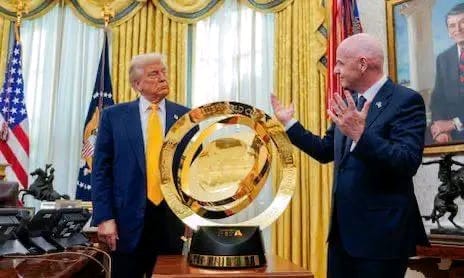The Club World Cup remains one of the most prestigious and lucrative competitions in world football. The 2025 edition, hosted with grandeur and global anticipation, delivered not only exhilarating football drama but also financial windfalls for participating clubs. It marked a momentous chapter in football’s economic landscape, driven by record-breaking revenues, global audience engagement, and star-studded off-field appearances, most notably former U.S. President Donald Trump’s attendance at the final. Yet, amid all the excitement and financial gains, one narrative stood out as both shocking and humbling: Chelsea’s failure to qualify for the 2026 edition.
Record Revenues: A Historic Financial Benchmark
The 2025 Club World Cup wasn’t just a football tournament—it was a global business phenomenon. FIFA’s revamped format, with 32 participating teams from across all continents, generated enormous broadcasting, ticketing, and sponsorship revenue. According to financial reports disclosed by various media outlets and club executives, the total revenue generated by clubs collectively exceeded $2.7 billion, setting a new benchmark for club competitions.
Much of this growth stemmed from diversified revenue streams. For the first time, the tournament fully capitalised on digital streaming, regional broadcasting rights, exclusive merchandise deals, and fan engagement activations powered by tech partnerships.
FIFA’s enhanced prize money structure also played a crucial role. The winning club took home $120 million, while runners-up, semifinalists, and quarterfinalists earned amounts ranging between $30 million and $80 million. Even group-stage participants were guaranteed a baseline participation fee of $10 million, making the tournament financially viable for clubs of all sizes.
Commercial Triumph: Branding Meets Football
With the expansion to 32 teams, brands saw the Club World Cup as an untapped goldmine. Major sponsors such as Coca-Cola, Visa, and Amazon Web Services deepened their involvement, investing hundreds of millions in branding activations, digital campaigns, and pitch-side advertising.
European giants like Real Madrid, PSG, and Manchester City each signed short-term sponsorship extensions directly tied to the tournament, reportedly worth between $15 and $25 million apiece. Clubs from Asia and Africa, such as Al Hilal and Mamelodi Sundowns, also attracted multinational corporate attention, highlighting the growing global footprint of football beyond the traditional elite.
Merchandise sales during the tournament spiked across all hosting venues. Replica kits, player jerseys, and club memorabilia flew off shelves, and pop-up stores inside stadium precincts reportedly sold over $150 million worth of merchandise collectively. Some clubs, like Inter Miami, even launched limited-edition kits exclusively for the Club World Cup, which sold out within hours online.
Ticket Sales and Stadium Revenue
With matches hosted across major global cities, including Paris, Tokyo, São Paulo, and Riyadh, stadium attendance averaged 82,000 fans per game—a record in Club World Cup history. Final matches sold out weeks in advance, and resale ticket prices soared to over $5,000 in some instances.
Stadium concessions, VIP hospitality suites, and fan zones turned into mini goldmines. Manchester City, for instance, is believed to have earned over $25 million in matchday revenue across four matches, covering everything from ticketing to hospitality. Smaller clubs like Club América and Al Ahly also capitalised by organising community-driven fan events that generated additional local revenue.
Broadcast Revenue: Football’s New Frontier
In 2025, the Club World Cup smashed television viewership records. With over 1.8 billion people tuning in globally throughout the tournament, broadcasting became the single largest revenue-generating pillar.
ESPN, Sky Sports, Canal+, and other international media giants reportedly paid over $1.2 billion collectively for global broadcast rights. For clubs, this translated into significant payouts, with FIFA’s revenue-sharing model allowing for direct disbursements based on match appearances, viewership metrics, and advancement through the tournament stages.
Social media streaming platforms such as YouTube TV and Amazon Prime Sports also played a massive role. Some clubs struck their streaming partnerships. For instance, Bayern Munich streamed behind-the-scenes content for premium subscribers, generating an estimated $3 million in digital subscriptions during the tournament.
Donald Trump Steals Headlines at the final.
The final between Chelsea and PSG at the iconic Lusail Stadium in Qatar was a spectacle of sport, celebrity, and politics. Among the high-profile attendees was former U.S. President Donald Trump, who arrived dramatically with his entourage and took his seat in the VIP box alongside FIFA President Gianni Infantino and Qatari royalty.
Trump’s presence added a layer of geopolitical intrigue and media buzz to the final. Journalists from around the world speculated about his intentions—was it pure football fandom, a public relations move, or part of his political rebranding? Regardless, cameras frequently cut to the former president, and his attendance trended globally on social media for 48 hours straight.
In his brief interaction with the press, Trump praised the atmosphere, saying, “This is one of the most beautiful sporting events I’ve ever attended. Tremendous energy. Tremendous people. The Club World Cup is a spectacular event.”
His endorsement, whether political or personal, drew attention from American viewers, especially in a nation where soccer continues to surge in popularity. U.S.-based clubs like Inter Miami and Seattle Sounders experienced a measurable uptick in merchandise sales and web traffic in the aftermath.
Chelsea’s Heartbreak: Missing Out on 2026
While Chelsea basked in the spotlight during the 2025 final, their journey in the Club World Cup ended with a bittersweet twist. Despite their massive global presence and strong tournament run, Chelsea failed to qualify for the 2026 Club World Cup—a development that shocked fans, pundits, and analysts alike.
Their failure stemmed from UEFA’s qualification format, which considered consistent continental performance over a rolling three-year period. Chelsea’s early exits from the Champions League in both 2023 and 2024, combined with their sixth-place finish in the 2024/25 Premier League season, ultimately cost them a spot in the expanded 2026 tournament.
The implications are significant, both reputationally and financially. Missing out on the 2026 edition means forfeiting potential revenues ranging from $30 to $120 million. It also affects their ability to attract top-tier players and commercial sponsors who prioritise global exposure.
Club insiders admitted that missing the next edition would “force a reassessment” of strategic priorities. Managerial changes, squad overhauls, and an intensified focus on UEFA competitions are expected as part of Chelsea’s rebuild to ensure they return stronger for the 2029 edition.
PSG, Real Madrid, and Others: Capitalising on Momentum
While Chelsea faces the consequences of exclusion, other clubs are riding the wave of success. PSG, the 2025 champions, reportedly raked in over $150 million from their run—$120 million in prize money and an additional $30 million in sponsorship and merchandise bonuses.
Real Madrid, Manchester City, Palmeiras, and Al Hilal—all semifinalists or top performers—also reported record earnings that boosted their financial year.
PSG’s win cemented their rise post-Mbappé era and gave players like Ousmane Dembélé and Warren Zaïre-Emery a chance to shine on the world stage. Their financial windfall is expected to fuel reinvestment in squad depth, academy development, and global marketing campaigns aimed at expanding their fan base in Asia and North America.
A Tournament That Redefined Club Football
The 2025 Club World Cup served as more than just a footballing spectacle. It redefined how global tournaments can deliver economic, cultural, and entertainment value on an unprecedented scale.
For clubs, it offered a lucrative and competitive platform to test their squads against the best from every continent. For fans, it provided drama, goals, heartbreak, and inspiration. For sponsors and media companies, it unlocked billions in advertising and engagement potential. And for global influencers like Donald Trump, it presented a platform to engage with a diverse, global audience in an apolitical setting.
Future Projections: 2026 and Beyond
With the 2026 edition set to be hosted in the United States, expectations are sky-high. Early forecasts project total club earnings could reach up to $4 billion if current trends continue. Already, tech giants like Apple, Google, and Meta have shown interest in sponsoring or broadcasting parts of the tournament.
For clubs like Chelsea, their immediate mission is redemption—qualifying for future editions and re-establishing their presence on the world stage. For others, the 2026 tournament is another golden opportunity to scale their brand and balance sheets.
One thing is certain—the Club World Cup has evolved into a premier event in the global football calendar, blending sport, finance, celebrity, and politics into a truly international phenomenon.










